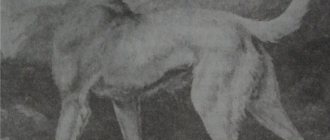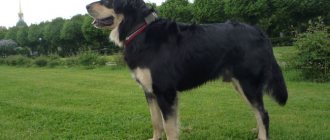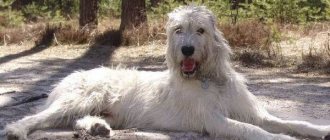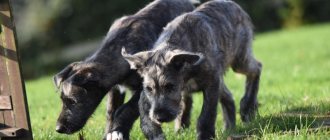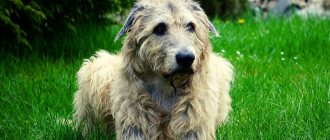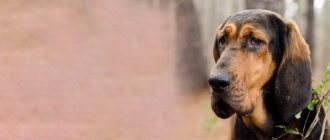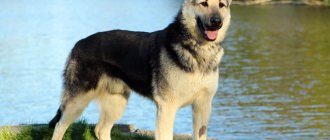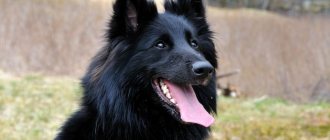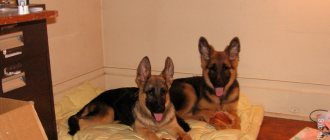History of the breed
There is currently no exact information about where exactly the Caucasian wolfhound comes from. There is an opinion that their ancestors were wolves and jackals. This is mainly due to the fact that these animals have many similar features, including physique.
However, it is generally accepted that the wolfhound or Caucasian Shepherd Dog is a type of Central Asian dog, originally from the Caucasus or Dagestan.
The first mention of dogs is found in 1121 BC. In those days, giant dogs were considered sacred animals, especially in Ancient Egypt and Greece. Much later, in the 18th-19th centuries, dogs began to be used for police service. The main direction of their activity was to search for missing people.
How to choose a puppy
Before choosing a specific puppy, it is advisable to immediately decide on the purpose of its adoption (exhibition activities, service, pet), because the cost of the baby depends on this. It is also important to choose your future friend based on gender: females are more good-natured and suitable for families with children, males are dominant creatures, so they are categorically not recommended for inexperienced owners, but they are excellent guards.
When the main issues have been resolved, you should look for a breeder of the breed. It would be better if it was a kennel specializing in Caucasian Shepherds. You can get a puppy from your hands, which will subsequently become extremely aggressive, especially with lax training, which, given the size and weight of the dog, can be dangerous for the owners themselves.
The guarantee of a puppy’s purebredness will be its metric and the pedigree of its parents. Otherwise, it is not easy to distinguish a baby from a mixed breed of another shepherd dog. A nuance that you should pay special attention to is the limbs. “Caucasians” have very wide ones from birth. Don't be fooled by the idea that paws will become more powerful with age, this won't happen.
Caucasian Shepherd puppies should have thick, wide paws
An indirect sign not so much of the breed as of the breeder's responsibility will be the puppy's cropped ears and the absence of his dewclaws.
Among the litter, you should choose more active and sociable puppies, especially if they are planned for further guard service. But bullies and fighters are more difficult to educate; these are the first signs of future waywardness.
The cost of pet-class “Caucasians” starts from 25 thousand rubles. If the baby has the prospect of an exhibition career, its price can reach up to 60 thousand rubles.
Description of the breed
The main qualities and requirements are regulated by the standard. Caucasus is a massive and very strong dog. He is a large dog with thick, long fur and undercoat. So the animal can easily withstand almost any weather conditions.
The weight of a dog can reach 120 and 130 kg. However, it all depends on your diet. At the same time, even with such a large mass, the dog will not be considered fat. These are his normal indicators.
The wolfhound's body is well developed, has a strong skeleton and muscles. All this is covered with a thick layer of skin.
Long fur
Character
Owners of Pikines, Chihuahuas, and Yorkshire terriers consider wolfhounds to be vicious and aggressive dogs. If a Caucasian is raised correctly, the pet behaves calmly and becomes obedient, although the dog’s character is different:
- persistence;
- love of freedom;
- stubbornness;
- determination;
- dedication.
Reference! The Caucasian does not bark without reason, but is wary of strangers. The wolfhound is very attached to its owner, although it rarely shows emotions; staying at home, it finds something to do, but it is difficult for the dog to survive a long separation from the owner.
Breed characteristics
According to the characteristics, the wolfhound has the following indicators:
- The length of the fur reaches 10-12 cm if it is long and 6-7 cm if it is short.
- An adult male reaches 68 cm at the withers, with an average weight of 50-60 kg. Girls grow up to 62 cm with a weight of 42-55 kg.
- They have high intelligence and are easy to train.
- They cannot live on the territory of the apartment, only in the enclosure.
- Shedding periods are quite difficult; the dog sheds its fur profusely.
- They are excellent hunters and watchdogs.
Important! The Dagestan wolfhound has a very calm and balanced disposition. But it is not suitable for everyone. The owner must have an iron will to raise such a giant correctly.
Working qualities
In the Caucasus, shepherd dogs are still used for their intended purpose - they protect the herd and shepherd from wild wolves.
However, representatives of this breed have been recruited for service for many years. Many service dog handlers choose the Caucasian Shepherd Dog as a watchman in the surrounding area. Considering the external characteristics and character traits, it is not advisable to choose this breed as a companion. Caucasians have a complex character; in addition, almost every individual has a strong protective instinct.
Priotary individuals against the wolf
In the Caucasus, there is an ancient tradition that allows you to identify the best individual and test its working qualities. It consists of holding a special fight where dogs have the opportunity to demonstrate their strength and endurance. The fight made it possible to find the best defender, who then became a flock dog. The title of Champion went to those individuals who became winners throughout the season. After this, the Champion became a spiritual value.
Priotary dog
Working Shepherds are very hardy and unpretentious in food. Shepherds feed their charges corn and barley cakes, which are soaked in water left over from the production of goat cheese.
The best puppies up to 6 months are given goat's milk. Flock dogs obtain meat on their own: they hunt small animals, such as reptiles (snakes, lizards), and less often rodents (hares) and birds.
Flock Sheepdogs serve almost around the clock. They protect the herd from wild wolves, which are the main aggressors in the pastures. Several dogs will be able to give a worthy rebuff to a very strong enemy, even if the bear decides to attack an object guarded by Caucasians. The Bear does not consider the Sheepdog a threat; many shepherds say that in such fights several flock dogs can die at once. But even in such cases, the shepherds expect that they will rush at the angry bear without any doubt. Otherwise, they will prefer to get rid of cowardly individuals immediately.
Bite force of an adult Caucasian
In cynology there is such a thing as a grip. This is the use of teeth by a dog. It is measured in two quantities: jaw compression force and duration. By type, the grip is divided into 3 groups: strong, weak and dead. The Caucasian Shepherd is characterized by a strong grip - a strong instant bite followed by a tear.
The force of the bite can be measured in another quantity. Some sources indicate that the Caucasian bite is approximately 380-520 kg per m². Service dog handlers claim that the Shepherd's grip strength is 13.5 atmospheres. It's like being crushed by a tree 10 m high and about 22 cm in diameter.
People-oriented
Caucasian Shepherd Dogs can be divided into 3 groups: aboriginal, transitional and breeding. Aborigines are considered more resilient, strong and unpretentious. They have much better developed working skills, and the dogs themselves are less attached to humans. This feature is explained by the ability to make independent decisions.
The transitional group is the middle between aboriginal and factory dogs. They have already been subjected to human selection and have characteristic features of both groups. The factory group represents Sheepdogs, which are the result of breeding work. They are more human-oriented and become more attached to their owner. They are easier to raise and maintain.
Advantages and disadvantages
The breed has a lot of positive traits. So, in particular, the undoubted advantages include:
- calmness and restraint;
- stable psychological state;
- high intelligence;
- good vision;
- loyalty and devotion to a person;
- patronage and care of children, as well as other animals;
- unpretentiousness to content;
- pronounced qualities of a guard and a hunter.
As for the disadvantages, they are expressed as follows:
- stubbornness;
- From an early age, a puppy must be properly raised and trained;
- open hostility towards strangers;
- may show aggression.
Briefly about the main thing
- Wolfhounds are the oldest breeds that have undergone more than 4 thousand years of domestication by humans.
- They have fearlessness and courage. They boldly go after a wild beast, without fear of being wounded.
- Dogs cannot tolerate strangers, but they treat their household members well, love and value them.
- Wolfhounds require early socialization to avoid the development of ancient instincts of aggression and attack.
- You should only purchase a wolfhound puppy from breeders of the breed with many years of experience who know all the nuances of keeping it.
- Ideal, comfortable conditions for the development of a breed from the Wolfhound group are considered to be a large apartment or a private country house with a fenced area.
- All breeds are distinguished by good health and harsh character.
- The dog must be raised by an owner with canine experience working with large breeds.
Breed standard
The standards apply to any breed of dog. The same rule applies to Caucasians, also known as the Karachay dog breed. More details about the standards are described below.
Head
Quite massive and heavy. It has a wedge shape. The cranial part is voluminous and well developed. The cheekbones are pronounced.
Jaws and teeth
The Caucasian has a regular scissor bite. A complete set of teeth is 42 pieces. At a young age, the teeth are white, even, and quite large. The lower jaw is pressed tightly against the upper jaw. The incisors should be located on the same line.
Nose
The nose is wide. The lobe is quite voluminous and has a black or brown color, depending on the color of the fur.
Eyes
Wolfhounds have small eyes. They have an oval shape. The color is mostly dark, most often brown.
Ears
The ears are in a hanging state. Not long. The position should be above the animal's eye line. Triangular shape.
Attention! In some cases related to the dog’s health, docking is allowed.
Neck
The neck is short. However, it has a powerful build. Very strong, covered with a thick layer of leather that moves freely, providing additional protection.
Frame
The body forms an almost horizontal line. Very powerful, with well-developed muscles.
Limbs
The paws are straight and parallel. On the hind legs the coat is much thicker and denser.
Tail
The tail is long and set high. The fur completely covers it. In its normal form it can be in the form of a sickle, hook or ring. It is also sometimes stopped.
Wool color may vary
Wool
The coat is straight, long and rough to the touch. On the head and front legs it is slightly shorter than on the rest of the body. May be longer on hind legs. The undercoat is thick and light.
Color
Fur color may vary. The following colors are allowed:
- pale yellow;
- ginger;
- with spots;
- brindle;
- white;
- brown;
- zonal gray.
Important! The color of a dog can be either monochromatic or consisting of several colors. At the same time, both spots and stripes may appear on the fur.
Disqualifying faults
Any departure from the standard is a disqualifying fault. Rejection is carried out for incorrect bite, too light eye shade, short legs and torso, and so on.
Features of care
Caucasian Shepherds are unpretentious dogs; they do not require careful grooming. But in order for the pet to be healthy and active, a minimum of procedures will still have to be carried out.
Hygiene
Taking care of the shepherd's fur will take up the most time from the owner. Without regular care, it becomes tangled, which gives the pet an unkempt appearance. Therefore, the dog should be combed at least once a week with a sparse comb and brush. During periods of shedding, this should be done at least every other day. Dead hairs clump tightly together and cause discomfort for the dog.
If the individual is not participating in exhibitions, the fur on the paws and legs can be cut short to make it easier to care for in wet and dirty weather.
Dogs are washed rarely (once a year), and this is not easy to do, given their large size. It is better to give your pet the opportunity to swim in open waters to his heart’s content in the summer, especially since “Caucasians” are excellent at this. In winter, you can rub the fur with snow and then let the dog dry in a warm place.
The ears of shepherds overgrown with hair often become the target of ear mites and the development of otitis media. Therefore, they need to be examined once a week, the external auditory canal should be cleaned with a damp cotton pad, and internal dirt should be softened using special zoo lotions (Veda, Bars). If your pet frequently shakes its head and scratches its ears, this is a reason to take it to the veterinarian for examination.
The eyes are wiped with cotton pads as they become dirty, and the appearance of signs of inflammation (purulent discharge) is observed.
It is recommended that Caucasian Shepherds, like other breeds, brush their teeth at least once every 2 weeks. But it is unlikely that it will be possible to get into the mouth of an adult with a brush. Therefore, pets are accustomed to the procedure at puppyhood. If brushing teeth becomes a regular activity, it will not cause protest in an adult dog. For the procedure, special zoopastes and brushes are used; to prevent tartar, the pet is given beef bones or special treats made from dry veins to chew on.
Ear cropping
Previously, all Caucasian Shepherd dogs had their ears cropped. This was due to the high risk of injury in fights with wolves. Now this remains at the discretion of the owner, if the individual is not an exhibition one.
Puppies' ears are traditionally cropped in the first days of life.
Puppies' ears are cropped in the first days of life (up to 5 days after birth). Then they thicken, and the procedure becomes dangerous. Then they wait until the dog is 1 year old to perform docking under anesthesia.
It is important to entrust this procedure to a veterinarian, otherwise you can provoke severe bleeding, which, given the small age of the puppy, can be fatal for him.
Walk
Although “Caucasians” are not as active as many other types of shepherd dogs, they need walking. It should occur at least twice a day for an hour. At this time, it is advisable to involve your pet in outdoor games, or better yet, in performing some tasks, because this giant will not mindlessly wear a retrieval harness. He thinks about all his actions and carries them out if he considers them important or necessary.
When walking a Caucasian Shepherd dog in crowded places, it is necessary to wear a muzzle and a short leash. Children under 14 years of age are prohibited from accompanying such a pet alone.
Feeding
Caucasian Shepherd Dogs, despite their impressive size, are small-toed and absolutely not picky. But this does not mean that you can neglect a properly formulated diet. The basic requirements for their feeding are the same as for other dogs: food from the owner’s table is strictly contraindicated, as are all sorts of “goodies” in the human concept (smoked meats, sweets, baked goods).
The basis of feeding should be lean meat (beef, horse meat, turkey). It is alternated with offal and sea fish (no more than once a week, boiled). A complement to the meat are cereals (rice and buckwheat), which need to be well boiled. Be sure to include stewed or boiled vegetables and fruits (apples, pears), cottage cheese, eggs (1 piece 2 times a week) into your diet.
The digestive system of Caucasian Shepherds is capable of digesting milk, which causes indigestion in most dogs. But you can only give it if your pet has been using it since childhood. After a long break, the introduction of this product can also cause diarrhea in the dog.
Among ready-made foods, you should choose those that are intended for giant breed dogs. They contain chondroitin, which protects joints from premature wear:
- Acana Adult Large Breed;
- Royal Canin Giant Adult;
Foods for large dogs have larger kibble sizes and contain chondroitin, which protects joints.
- Eukanuba Adult Large breed.
The daily diet of a Caucasian Shepherd dog is calculated using the approximate formula: 40 g of natural food or 15 g of ready-made food per 1 kg of dog weight.
Health and illness
Wolfhounds have excellent health. However, this does not mean that you should ignore trips to the veterinarian and routine vaccinations. All this must be carried out in accordance with the established deadlines.
Dogs are still susceptible to some diseases. These include:
- allergy;
- atrophy of the visual organs;
- cardiac dysfunction;
- muscle convulsions.
Important! Any changes in the dog’s behavior or well-being are a reason to visit the veterinarian.
Interesting Facts
Despite their menacing appearance, Caucasians need human attention and affection. They love to be petted and talked to. At the same time, the dogs are quite independent and can work in a team. Because of this quality, animals were often used in guard services.
Dogs were also used during the Russian-Turkish war. Turkish warriors specially raised and trained animals for these purposes. Afterwards, dogs began to be hired as guards.
The article tells you everything you need to know about the powerful northern dogs. They are not suitable for everyone, but they can become loyal and irreplaceable friends. You just need to properly raise and love a huge dog. And then he will share his devotion and will be with the person all his life.
Keeping a Caucasian Shepherd Dog
The Caucasian Shepherd can be kept both in an apartment and in a private house, but it is worth considering a number of nuances:
- The dog is a giant breed, so it will be cramped in an average apartment.
- A shepherd dog requires physical activity most of the day, which is extremely difficult to provide at home. Excess energy can lead to destructive behavior in your pet.
- “Caucasians” shed very profusely, making it difficult to keep the house clean during these periods.
- Every stranger who crosses the threshold of the apartment is perceived by the shepherd as an aggressor, so the owner will have to carefully monitor its reaction.
The main fact in support of keeping a Caucasian Shepherd dog on the street is that these dogs are perfectly adapted to the harshest living conditions. The pet has enough shelter from strong winds and rain (most often this role is played by a spacious enclosure with a booth). The resting place should be located in such a way that the shaggy watchman can calmly inspect the territory entrusted to him. At the entrance to the dog-protected area there should be a sign notifying the presence of a shepherd dog (for example, “Beware, angry dog!”).
It is possible to put a guard on a chain, but this should be a short-term measure to, for example, allow guests into the house.
It’s good if a “Caucasian” has the opportunity to move freely around a protected area
